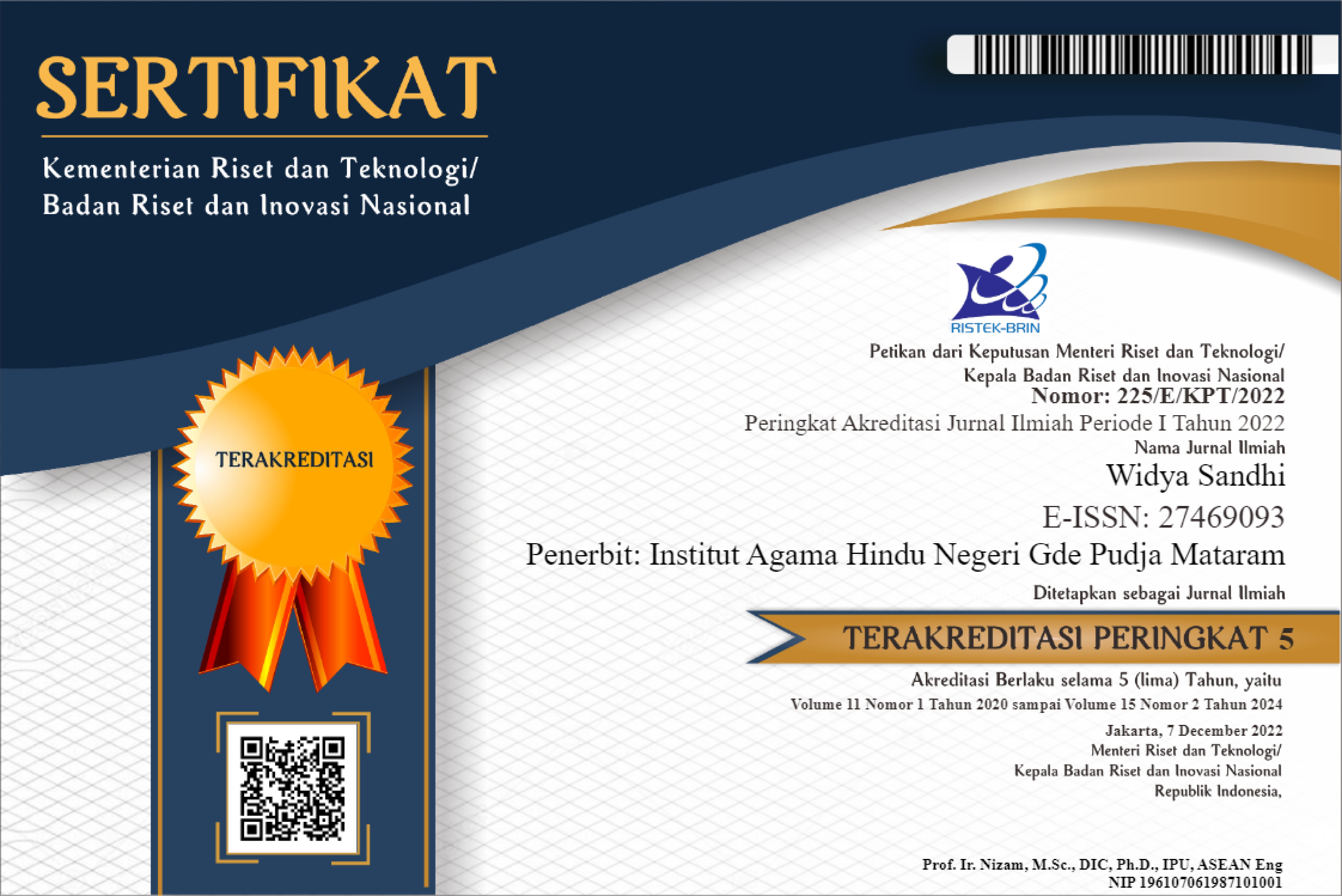KOMUNIKASI RITUAL PAWAI OGOH-OGOH SEBAGAI IMPLEMENTASI DALAM TRI HITA KARANA
Abstract
The Ogoh-ogoh parade is one of a series of Nyepi activities. In the implementation of the ogoh-ogoh parade which was held in the city of Mataram, it did not only involve Hindus, but also Muslims, Buddhists, and Christians. Ogoh-Ogoh is one of the works of sculpture that depicts the embodiment of Bhuta kala, Bhuta kala in Hinduism is described as the embodiment of a giant whose figure is known for its large and frightening size.
The purpose of this study is to describe and analyze the implementation and values contained in the teachings of tri hitakarana in the tradition of the ogoh-ogoh parade in Mataram City. This study used qualitative research methods.
The results of this study are as follows: Ritual Communication of the Ogoh-Ogoh Parade as Implementation in Tri Hitakarana, including, 1) The Parhyangan conception is implemented before carrying out the ogoh-ogoh parade, where before the event begins the community performs a melaspas ceremony. 2) Conception Pawongan is the concept of harmonization between fellow humans, the implementation of which in the parade is not only the Hindu community who are involved as paratroopers or gamelan musicians, but there are also non-Hindu relatives that we meet bringing kecimol, gendang beleq and even barong sai to participate in the celebration and celebration. the success of the ogoh-ogoh parade. 3) The concept of Palemahan is implemented when after carrying out the ogoh-ogoh parade, the community then performs a mass mecaru ceremony or at their respective homes. The values contained in the Ritual Communication of the Ogoh-Ogoh Parade as Implementation in the Tri Hitakarana are, 1) Religious or Spiritual Values, believing in the existence of God which is believed by Hindus or the people of Mataram City. 2) Social Values and Religious Tolerance, mutual respect among Hindus or among each other despite different religions and beliefs, without anyone looking at social status, whether position, caste or wealth in order to achieve common goals, all work hand in hand enthusiastically, sincerely, sincerely and concern for others. 3) Art value, contained in the manufacturing process, where in making ogoh-ogoh techniques are needed in making and have a high artistic spirit by having an artistic soul so that person can pour ideas according to the desired imagination, not only looks good to the eye but also able to give an impression and meaning to everyone who observes the work of art.
References
Felix, J. (2012). Pengertian Seni SebagaiPengantar Kuliah Sejarah SeniRupa. Humaniora, 3 (2), 614–621.
Gunawan, dkk. (2016). Seni Ogoh-Ogoh (Konteks,Teks dan Efek). Jurnal Prabangkara Seni Rupa Dan Desain, 19 (1).
Indrayana, K. A. (2006). Ogoh-ogoh dalam Ritual Nyepi di Bali: Sebuah Kajian Budaya. Program Studi Magister (S2) Kajian Budaya, Universitas Udayana.
Prabandari, dkk. (2021). Dampak Pawai Ogoh-Ogoh Terhadap Sosial Budaya Masyarakat Di Desa Adat Kuta. Jurnal Pariwisata Budaya: Jurnal Ilmiah Pariwisata Agama Dan Budaya, EISSN 2614-5340).
Purnami. (n.d.). Nilai Kearifan Lokal Tradisi Ogoh-Ogoh Di Desa Ruos Kabupaten Oku Selatan Sebagai Sumber Pembelajaran Sejarah Di Pasraman Widya Dharma. Jurnal Kalpataru, 6, Nomor 1, 30–38.
Rahmawati, A. (2018). Studi Tentang TradisiOgoh-Ogoh Menyambut Hari RayaNyepi di Pura Adhya Jagad Karana DesaBesowo Kecamatan Kepung KabupatenKediri. Simki-Pedagogia, 5 (2).
Wiana, I. K. (2009). Suksmaning Banten. Paramita.
Yunaini, Y., & Sholeh, K. (2018). SejarahPengobatan Tradisional di DesaSimpang Tais Sebagai SumberPembelajaran Sejarah. Kalpataru JurnalSejarah Dan Pembelajaran Sejarah, 4(1), 48–59.

This work is licensed under a Creative Commons Attribution-NonCommercial-ShareAlike 4.0 International License.
Authors who publish with this journal agree to the following terms:
- Authors retain copyright and grant the journal right of first publication with the work simultaneously licensed under a Creative Commons Attribution-ShareAlike 4.0 International License. that allows others to share the work with an acknowledgment of the work's authorship and initial publication in this journal.
- Authors are able to enter into separate, additional contractual arrangements for the non-exclusive distribution of the journal's published version of the work (e.g., post it to an institutional repository or publish it in a book), with an acknowledgment of its initial publication in this journal.
- Authors are permitted and encouraged to post their work online (e.g., in institutional repositories or on their website) prior to and during the submission process, as it can lead to productive exchanges, as well as earlier and greater citation of published work (See The Effect of Open Access).






.jpg)




